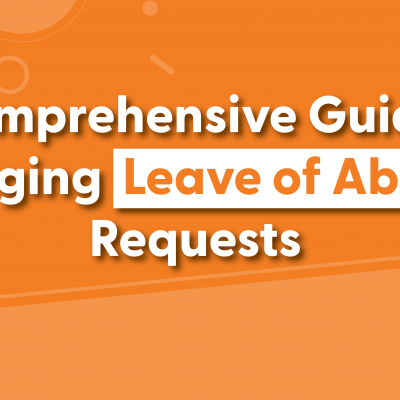We speak with HR and People Ops leaders all over the country, across all industries, at organizations of all sizes, and one thing we’ve learned is that no two organizations manage their leaves of absence quite the same. Furthermore, individual organizations often are often managing different types of leave inconsistently, exposing themselves to potential compliance violations.
While more and more HR leaders are opting to ditch their FMLA tracking spreadsheets as they turn to the leave experts (like Tilt) for support, no matter your approach to managing leaves, having a consistent process for managing all leaves is a critical component of operational efficiency and compliance.
Below we’ll outline everything that goes into managing a leave successfully so you can ensure you’re doing everything that’s required. For the sake of simplicity, we’re going to cover employees who are covered by FMLA.
1. How to Determine Leave Eligibility for Employees
One of the foundational steps in effectively managing an employee’s leave of absence is to determine their eligibility for the requested leave. As an HR leader, the meticulous review of the employee’s situation, considering both company policies and relevant employment laws, is step one.
Factors to consider are:
- The employee’s tenure.
- The type of leave requested.
- Whether the employee has exhausted any prior leaves within the applicable timeframes.
Additionally, HR managers should be well-versed in the complexities of various leave laws, including the Family and Medical Leave Act (FMLA) and the Americans with Disabilities Act (ADA), to ensure that the employee’s request aligns with legal requirements. Establishing eligibility sets the groundwork for a fair and compliant leave management process, offering transparency and clarity to both the employee and the organization.
2. The Importance of Leave of Absence Communication
Leaves of absence are some of the most human experiences your employees can have while navigating work and life, and effective communication is at the heart of a successful journey. We recommend establishing a transparent and empathetic dialogue with the employee who has requested leave as you clarify the process for them, outline available options, and ensure that they understand their rights and responsibilities.
By openly discussing the types of leave available, potential impacts on their job and benefits, and any necessary documentation requirements, you can help employees make informed decisions about their leave. This initial communication also demonstrates your organization’s commitment to supporting your employees during challenging times, fostering a sense of trust and goodwill.
Establish a well-defined communication plan and make sure your communications to employees is never about work or have them feeling they should return to work prematurely. It’s important to determine the frequency and method of communication with your employee, which may include email, phone calls, virtual meetings, or a combination of all three. Regular updates help the employee remain connected and informed throughout their absence, addressing any concerns promptly.
Similarly, providing ongoing support and assistance to employees throughout their leave of absence by promptly addressing any questions or concerns that may arise during the leave journey.
3. Required Documentation for a Leave of Absence
If communication is the heart of managing a leave of absence, accurate documentation is the backbone. Ensure that the necessary paperwork is carefully collected and maintained. You may need to request and verify documentation such as medical certificates for medical leaves, relevant forms pertaining to parental leaves, or various forms required for applicable state benefits. These documents serve as evidence of the leave’s legitimacy and are vital for compliance with both company policies and legal regulations.
Maintaining an organized record of the leave request, start and end dates, and the reason for leave not only facilitates the approval process but also helps in addressing any potential disputes or inquiries that may arise in the future. Effective documentation safeguards the interests of both the employee and the organization.
4. Record-Keeping Requirements for a Leave of Absence
It is essential to establish and adhere to a structured record-keeping system to manage leaves of absence efficiently. Maintain organized and confidential records of the entire leave process, including the leave request, documentation, approvals, and any relevant correspondence. These records serve as a historical reference, aiding in compliance with legal requirements and facilitating internal audits or investigations, if necessary. Proper documentation also helps in addressing potential disputes, verifying benefits, and ensuring that the employee’s rights and the organization’s responsibilities are upheld consistently throughout the leave of absence.
These records should be securely stored, organized, and readily accessible if needed for audits, legal inquiries, or employee requests. Compliance with documentation retention protocols ensures that the organization can demonstrate its adherence to legal regulations and provides a historical reference for past leave cases, contributing to transparency and accountability in leave management practices.
5. How to Define Your Leave of Absence Policies
Thoroughly familiarizing the employee with your organization’s leave policies is a fundamental step in effective leave of absence management. Provide employees with easy-to-access, comprehensive information about your policies regarding pay continuation, benefits coverage, and job protection during the leave.
Explaining your policies clearly helps your employees understand their entitlements and responsibilities, setting clear expectations. Moreover, it ensures that your employee population is aware of any of your specific company provisions that might apply to their situation, such as using accrued paid time off before taking unpaid leave. This clarity enhances compliance, minimizes potential misunderstandings, and contributes to a smooth and legally sound leave process.
6. Creating a Good Leave of Absence Approval Process
Please note that after evaluating the employee’s request and accompanying documentation, obtaining the necessary approvals from upper management may be required. This step ensures that all leave requests align with your organization’s policies and legal obligations, promoting consistency and fairness.
Promptly communicating the approval or denial of the leave request, with clear reasons for any denials, is essential for transparency and employee engagement. Establish a well-managed approval process to not only uphold compliance with regulations but also to foster a positive working relationship by showing that employee concerns are taken seriously and fairly assessed.
7. Building a Leave of Absence Return-to-Work Plan
Prepare a comprehensive return-to-work plan that outlines the specifics of your employees’ return. Include the date that work will resume, and address any accommodations or modifications required to facilitate the employee’s smooth reintegration into the workplace.
Conduct a return-to-work meeting with the employee to discuss any updates, changes, or transitional arrangements upon their return. After the employee returns, it’s a good practice to assess their performance and well-being to ensure they’ve had a smooth transition.
Emphasizing a successful return-to-work experience is a vital component of any organization’s leave of absence process. Effective communication at this stage ensures that both the employee and your organization are well-prepared for their transition back to work life, which for some employees can be a significant transition. minimizing any potential disruptions.
8. Leave of Absence Coordination with Payroll
The accurate and timely processing of the employee’s pay during their leave period is paramount to a successful leave for a variety of reasons. Not only is it a top priority for your payroll team’s record-keeping, but accurate payments help ensure that your employee’s financial well-being is maintained during their absence, which is especially critical for medical or family-related leaves.
Your leave of absence payroll process should include tracking paid and unpaid benefits, statutory benefits, and making necessary adjustments to the payroll system as promptly as possible to avoid overpayments or underpayments. By closely collaborating with payroll throughout the leave process, you can prevent financial disruptions and ensure a seamless transition for the employee returning from leave.
9. Job Protection Rules for a Leave of Absence
If the leave is job-protected, by the FMLA or otherwise, you’re required to ensure that the employee’s job title (or equivalent) and employment status are secure while they are away. This protection may extend to preventing any discrimination or retaliation related to their leave request. Upholding job protection promotes employee loyalty, reduces turnover, and helps your organization remain compliant with labor laws and regulations.
10. Complying With Leave of Absence Regulations
Stay up-to-date with evolving laws, such as the Family and Medical Leave Act (FMLA), Americans with Disabilities Act (ADA), and state-specific leave laws. (Tilt tip: bookmark this page of leave law reports and check it quarterly).
Since non-compliance can lead to legal consequences and financial liabilities your org wants nothing to do with, make it a practice to regularly review and adapt your policies to align with these legal requirements. Compliance not only protects your organization but also upholds the rights of your employees to help establish a work environment that values and respects the law while promoting fairness and equity in leave of absence management.
When in doubt, consult with legal counsel on any matters that involve compliance with leave of absence laws and regulations.
About Tilt
Tilt is leading the charge in all things leave of absence management through easy-to-use tech and human touch. Since 2017, our proprietary platform and Empathy Warriors have been helping customers make leave not suck by eliminating administrative burdens, keeping companies compliant, and providing a truly positive and supportive leave of absence experience for their people.







